Bandit216
Well-known member
- Thread starter
- #1
Long Post:
Last winter I conducted a worse case cold weather range test of my Mach E at -35F. https://www.macheforum.com/site/thr...-mach-e-range-test-what-could-go-wrong.11669/ When the temperatures here in Fairbanks hit -40F this week, I couldn't contain myself - another chance to kill myself and set the cause of EVs back for 25 years (or not at all, depending on your political persuasion). This time it was the Lightning's turn.
Three main goals:
How does extreme cold affect Lightning mechanical reliability?
What is the Lightning's actual cold weather range in extreme cold?
How will extreme cold affect charging?
Secondary Goal:
Test a new 50kWh DC "fast" Charger at the turn around point, Delta Junction, Alaska. (If Delta Junction sounds familiar, it is home to the Fort Greely's Arctic test center where military equipment and most North American cars receive some of their cold weather testing. https://fordauthority.com/2022/03/2...ing-underwent-cold-weather-testing-in-alaska/ (The Mach E and Lightning were both tested there)
The Lightning: LR Lariat ~4,000 miles, with AT tires. All available software updates have been applied via FDRS (including the new Sync 4A update). Whereas the Mach E test was a worse case test (left outside overnight at -35, not plugged in, and no prestart or departure time set), this test was more of a recommended procedures kind of test. Like the Mach E, the Lightning was packed with an assortment of survival gear. Normal driving mode was selected, and 1 pedal driving was turned off. I used manual fan and climate control settings.
This time, my test vehicle was plugged in overnight, in a heated garage (~50 degrees), and had a departure time set. For both directions, the speed control was set to 59 mph. Other than a few minor elevation changes, the route was flat, and traffic was very light. The weather was clear and cold, with winds calm for most of the route - the exception was Delta Junction, where the temperature was a balmy -20F but the winds were gusting to 25 mph and the windchill was -55 F. The outbound and return legs were each 94.5 miles. Temperature and KWh used were determine using the Car Scanner App and a Nexas NexLink Bluetooth 5.0 OBD2 dongle.
In theory, an LR Lariat should easily handle the 190 miles round trip with KWh to spare. My original plan was: if the new 50kW charger isn't working I'll just turn around and drive home.
At the 0915 departure, the Lightning had 119 kWh of battery available showing in the Car Scanner app. The displayed charge on the driver display was 100% while the Car Scanner app showed a 94% charge. Battery temp was in line with the garage temp of approx. 50 degrees. Thanks to the departure time and climate settings, the car interior was in the 80s F range. That's normally way to warm for me, but I learned from the Mach E test that you don't want to start your cold weather trips with the interior temp set too low, because at extreme cold temps you just can't get the vehicle warm enough to grow bananas in the back seat (if a tropical rainforest is your spouse's natural environment.)
Instead of a verbose soliloquy (look it up), I'll use some pictures to summarize the trip down:
Icefog and Proof of -40F. The broken windshield happened the 2nd week I had the truck

10:44 AM. Just before sunrise on the outbound leg:

Within a half hour it did became clear that the 190-mile round trip, without charging, was out of the question - after I had gone 24 miles, I had used 22 kWh of electricity and had 97kWh remaining. As a complicating factor, there was conflicting information on whether the two new 50kW chargers in Delta Junction were actually operational yet.
Unlike the rest of North America where it is somebody else's job to do things for us, that hasn't been the case with our EV charging infrastructure in Alaska. The new Delta Junction 50kW charger and most of the DC chargers installed between Fairbanks and Anchorage have largely been the work of one young couple in Anchorage who have applied for grant's, used their own money, negotiated with landowners, enlisted a local power company (GVEA) and oversaw the installation of Alaska's current EV charging network - so, a big shoutout to Kris and Sara Hall at Recharge Alaska. (The State of Alaska already had a plan for expanding the EV charging network, even before the recent federal government benevolence, so it looks like we will see significant improvement to the statewide EV charging network. Given a choice, however, I'll be sending my business to the Recharge Alaska stations.)
Since the true status of the Delta Junction charger was unknown, I emailed Kris Hall before departing. He told me one of the chargers was working but he hadn't been able to test the credit card reader. He said if there was a problem with the credit card reader he would need about 15 minutes to remotely set the charger to free vend, so, I took a chance. I figured I could always find a local Level 2 charging option, if needed. I arrived at the charger with 42 kWh remaining, having used 76.19 kWh to travel the 95 miles. While the ambient temperature had "warmed" to -20F, the wind was howling and the windchill was -55 F. Despite multiple attempts with different cards I couldn't get the credit card reader to work. My fingers were numb from the wind chill, so I hopped back into the truck and opened my email to contact Kris. Waiting for me in my inbox was an email from Kris saying he had seen the charger time-out from my charging attempts and that he would set the charger to "free". I waited a few minutes, then reconnected the truck. After only 30 seconds, charging started and, despite the extreme cold, the charging rate ramped almost immediately to 45-46 kW. (I had tested my Lightning the previous day at the Fairbanks 50kW charger with temps at -42F and had seen about a 34 kW rate.)
First Leg Summary, Just Before Charging

Car Scanner App just before charging:

Nice but windy charging:

It took 76 minutes to add the 51 kWh I wanted for the return trip. For those of you who have already done the math, that doesn't match the charge rate I was seeing. That is, of course, because I was running the cabin heat for a good portion of the charge. According to the Car Scanner app, running the interior heat drew a very consistent 7-8 kW of power whenever I had climate control 'On' and Eheat selected - driving or not. I did turn off climate control to see what would happen and, somewhat surprisingly, the truck's inline heater began putting out 10-11 kW of power for about 5 minutes, then it dropped to zero. During those 5 minutes, the battery temperature sensor did increase from 24 degrees to 60 degrees. So, that confirms what others have written in the forum, heat goes to either the cabin or the battery, but apparently not at the same time. What did surprise me was that the heater was capable of providing an additional 2 kW to the battery that it didn't provide to the cabin during any portion of the drive. At -40, during the drive, the cabin had cooled down to the point where, while not unpleasant, the interior temperature could no longer be called 'warm'. I'm wondering if that extra 2 kW of heating power is never used in the cabin because it is reserved for other car warming requirements. Still an extra 2 kW of cabin heat would be nice at -40 - even with the associated range loss. While I used manual fan and climate control settings, I did select Auto climate a few times, but the temp always dropped fairly quickly in Auto. One thing I noticed (that I like): it appears there may have been some adjustment to the auto-defrost function. With my Mach E, auto-defrost was always coming on by itself and full blast. It would instantly replace warm cabin air with cold cabin air. Very unpleasant at very cold temps. I'm not sure if this improvement was by design or if I found some secret combination of manual switch positions or circumstances that overrides the annoying auto defrost.
The return trip was uneventful with remarkably consistent numbers for both legs of the trip. I did make the return trip 5-10 mph faster and attribute the nearly identical energy consumption numbers to the fact that although I was somewhat slower on the outbound leg, I was experiencing a fairly strong head wind on that leg.
1:47 PM. Sunset on the return leg:

Finish:

Trip Summary at -40F:
Outbound: Distance 94.5 miles, kWh used 76.19, miles\kWh 1.24
Return: Distance 95 miles, kWh used 77, miles\kWh 1.23
Summary of the three main goals:
How does extreme cold affect Lightning mechanical reliability? My experience of three winters in Alaska has been that neither the Lightning, nor the Mach E, have shown any mechanically related issues when driving in extreme cold. That wasn't the case with most of the non-EVs I've driven in the cold. Almost all of them struggled mightily to start, had easily broken fan belts, and made continuous painful noises when driving in extreme cold. Non-EVs do get the nod when it comes to growing bananas in the back seat, though.
What is the Lightning's actual cold weather range in extreme cold? On this trip, at -40, it was a remarkably consistent 1.23 mi\kWh. For the winter as a whole, since Nov 1st my Lightning has averaged right at 1.4 mi\kWh. My summer mileage was ~1.9 mi\kWh. The last two winters, my Mach E has averaged a very consistent 1.8 mi\kWh and my summer average has been ~2.8 mi\kWh. I can't verify the new cold weather GOM accuracy update because when I charged the truck to 100% prior to departure, it reset the GOM to the factory ideal range of approx. 315 miles. It wasn't until the very end of the trip before the GOM finally showed a fairly accurate range remaining that I would bet my life on.
How will extreme cold affect charging? My experience is based exclusively on 50 kW DCFC, but I've found the Lightning and Mach E charge reliably even at very cold temps. Charging performance remains fairly stable down to -20F then shows some charge rate taper below that. But in all case the vehicles charge fine. The charging station cable do get very stiff and difficult to bend in extreme cold. I am currently charging the Lightning, outside, at work (-35F) using a level 2 GrizzlE - without issue.
Other: I don't like the factory AT tires. The roads were dry(ish) for this trip and the grip was fine, but if there is any ice or packed snow, there is way too much tire slippage compared to the Continental winter tires that I bought for my Mach E. There aren't enough quality, 20" winter tire options for the Lightning.
BTW: The new Sync 4A display and the multi-purposed volume knob are nice improvements.
Last winter I conducted a worse case cold weather range test of my Mach E at -35F. https://www.macheforum.com/site/thr...-mach-e-range-test-what-could-go-wrong.11669/ When the temperatures here in Fairbanks hit -40F this week, I couldn't contain myself - another chance to kill myself and set the cause of EVs back for 25 years (or not at all, depending on your political persuasion). This time it was the Lightning's turn.
Three main goals:
How does extreme cold affect Lightning mechanical reliability?
What is the Lightning's actual cold weather range in extreme cold?
How will extreme cold affect charging?
Secondary Goal:
Test a new 50kWh DC "fast" Charger at the turn around point, Delta Junction, Alaska. (If Delta Junction sounds familiar, it is home to the Fort Greely's Arctic test center where military equipment and most North American cars receive some of their cold weather testing. https://fordauthority.com/2022/03/2...ing-underwent-cold-weather-testing-in-alaska/ (The Mach E and Lightning were both tested there)
The Lightning: LR Lariat ~4,000 miles, with AT tires. All available software updates have been applied via FDRS (including the new Sync 4A update). Whereas the Mach E test was a worse case test (left outside overnight at -35, not plugged in, and no prestart or departure time set), this test was more of a recommended procedures kind of test. Like the Mach E, the Lightning was packed with an assortment of survival gear. Normal driving mode was selected, and 1 pedal driving was turned off. I used manual fan and climate control settings.
This time, my test vehicle was plugged in overnight, in a heated garage (~50 degrees), and had a departure time set. For both directions, the speed control was set to 59 mph. Other than a few minor elevation changes, the route was flat, and traffic was very light. The weather was clear and cold, with winds calm for most of the route - the exception was Delta Junction, where the temperature was a balmy -20F but the winds were gusting to 25 mph and the windchill was -55 F. The outbound and return legs were each 94.5 miles. Temperature and KWh used were determine using the Car Scanner App and a Nexas NexLink Bluetooth 5.0 OBD2 dongle.
In theory, an LR Lariat should easily handle the 190 miles round trip with KWh to spare. My original plan was: if the new 50kW charger isn't working I'll just turn around and drive home.
At the 0915 departure, the Lightning had 119 kWh of battery available showing in the Car Scanner app. The displayed charge on the driver display was 100% while the Car Scanner app showed a 94% charge. Battery temp was in line with the garage temp of approx. 50 degrees. Thanks to the departure time and climate settings, the car interior was in the 80s F range. That's normally way to warm for me, but I learned from the Mach E test that you don't want to start your cold weather trips with the interior temp set too low, because at extreme cold temps you just can't get the vehicle warm enough to grow bananas in the back seat (if a tropical rainforest is your spouse's natural environment.)
Instead of a verbose soliloquy (look it up), I'll use some pictures to summarize the trip down:
Icefog and Proof of -40F. The broken windshield happened the 2nd week I had the truck
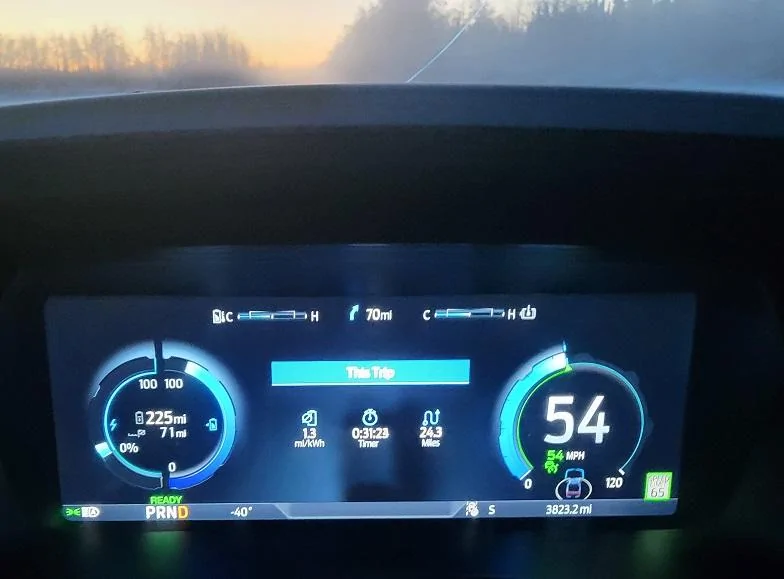
10:44 AM. Just before sunrise on the outbound leg:
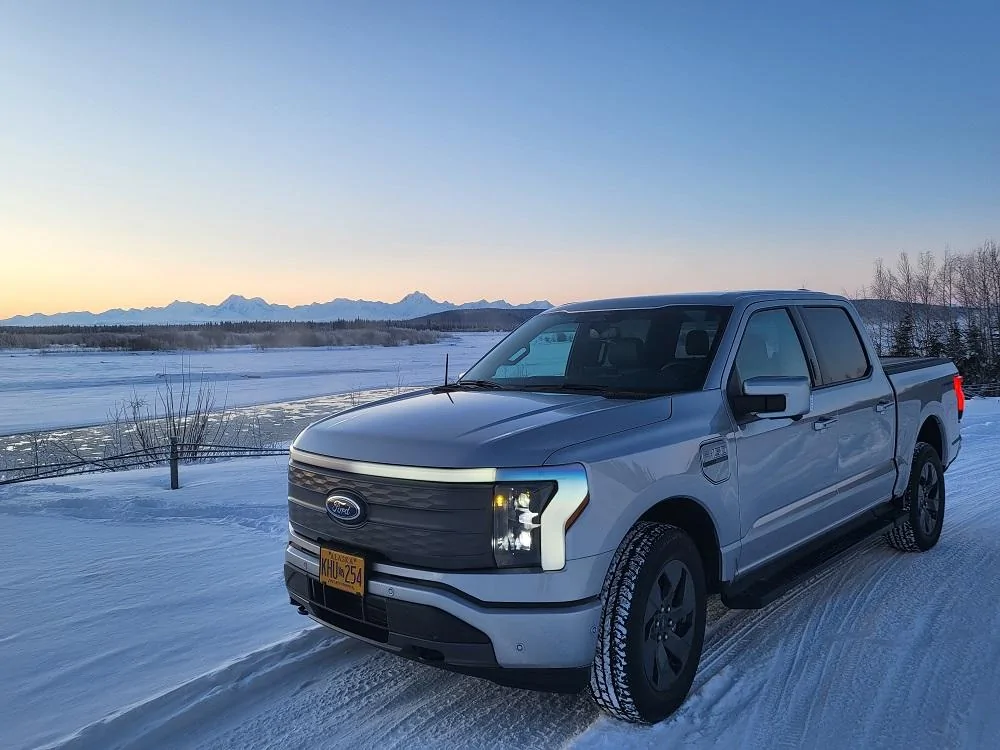
Within a half hour it did became clear that the 190-mile round trip, without charging, was out of the question - after I had gone 24 miles, I had used 22 kWh of electricity and had 97kWh remaining. As a complicating factor, there was conflicting information on whether the two new 50kW chargers in Delta Junction were actually operational yet.
Unlike the rest of North America where it is somebody else's job to do things for us, that hasn't been the case with our EV charging infrastructure in Alaska. The new Delta Junction 50kW charger and most of the DC chargers installed between Fairbanks and Anchorage have largely been the work of one young couple in Anchorage who have applied for grant's, used their own money, negotiated with landowners, enlisted a local power company (GVEA) and oversaw the installation of Alaska's current EV charging network - so, a big shoutout to Kris and Sara Hall at Recharge Alaska. (The State of Alaska already had a plan for expanding the EV charging network, even before the recent federal government benevolence, so it looks like we will see significant improvement to the statewide EV charging network. Given a choice, however, I'll be sending my business to the Recharge Alaska stations.)
Since the true status of the Delta Junction charger was unknown, I emailed Kris Hall before departing. He told me one of the chargers was working but he hadn't been able to test the credit card reader. He said if there was a problem with the credit card reader he would need about 15 minutes to remotely set the charger to free vend, so, I took a chance. I figured I could always find a local Level 2 charging option, if needed. I arrived at the charger with 42 kWh remaining, having used 76.19 kWh to travel the 95 miles. While the ambient temperature had "warmed" to -20F, the wind was howling and the windchill was -55 F. Despite multiple attempts with different cards I couldn't get the credit card reader to work. My fingers were numb from the wind chill, so I hopped back into the truck and opened my email to contact Kris. Waiting for me in my inbox was an email from Kris saying he had seen the charger time-out from my charging attempts and that he would set the charger to "free". I waited a few minutes, then reconnected the truck. After only 30 seconds, charging started and, despite the extreme cold, the charging rate ramped almost immediately to 45-46 kW. (I had tested my Lightning the previous day at the Fairbanks 50kW charger with temps at -42F and had seen about a 34 kW rate.)
First Leg Summary, Just Before Charging
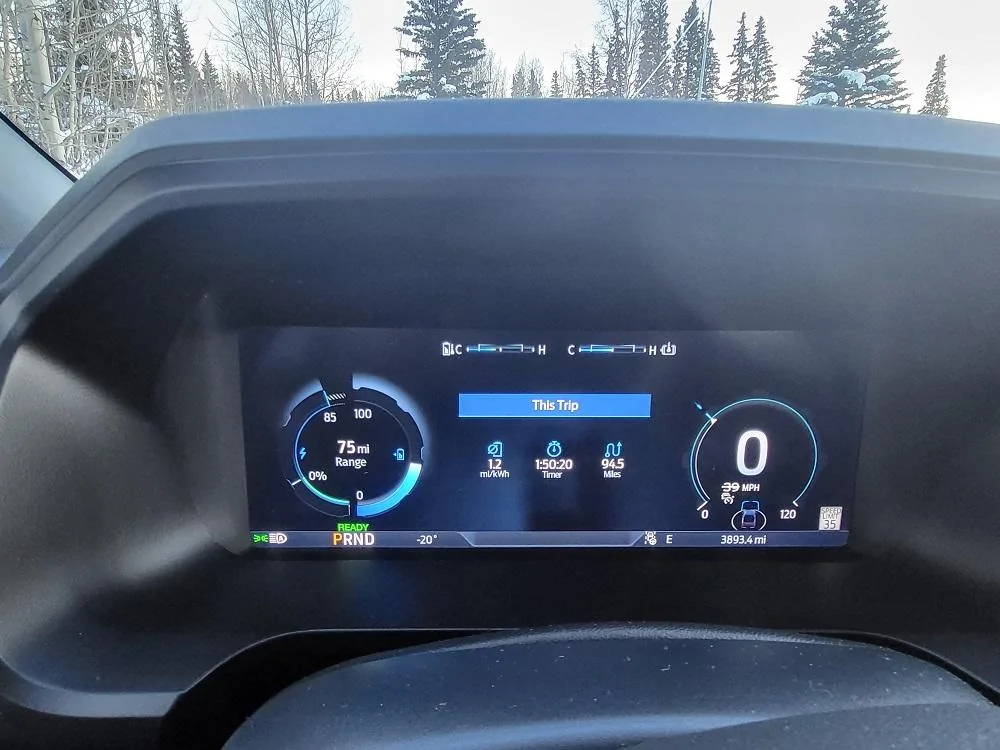
Car Scanner App just before charging:
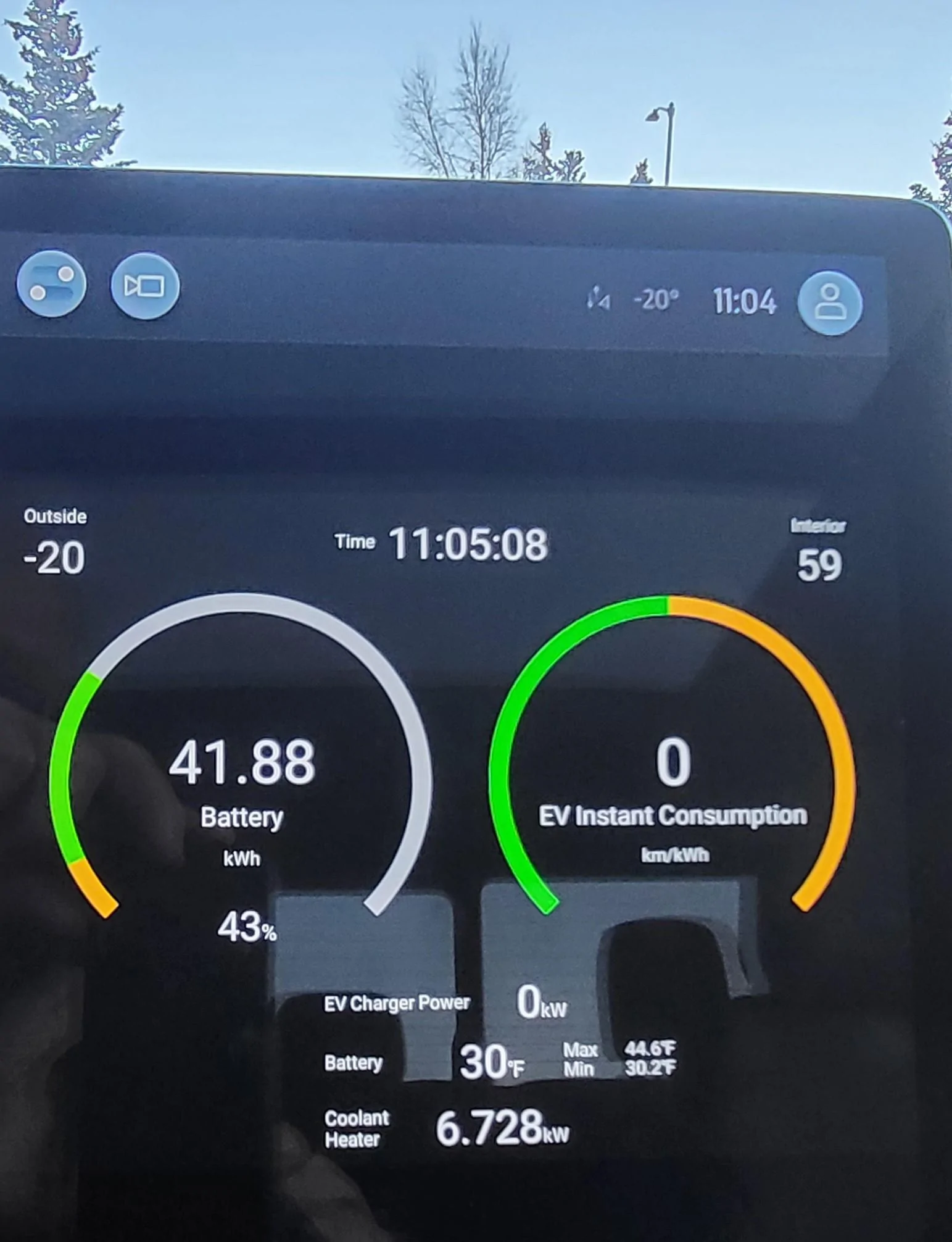
Nice but windy charging:
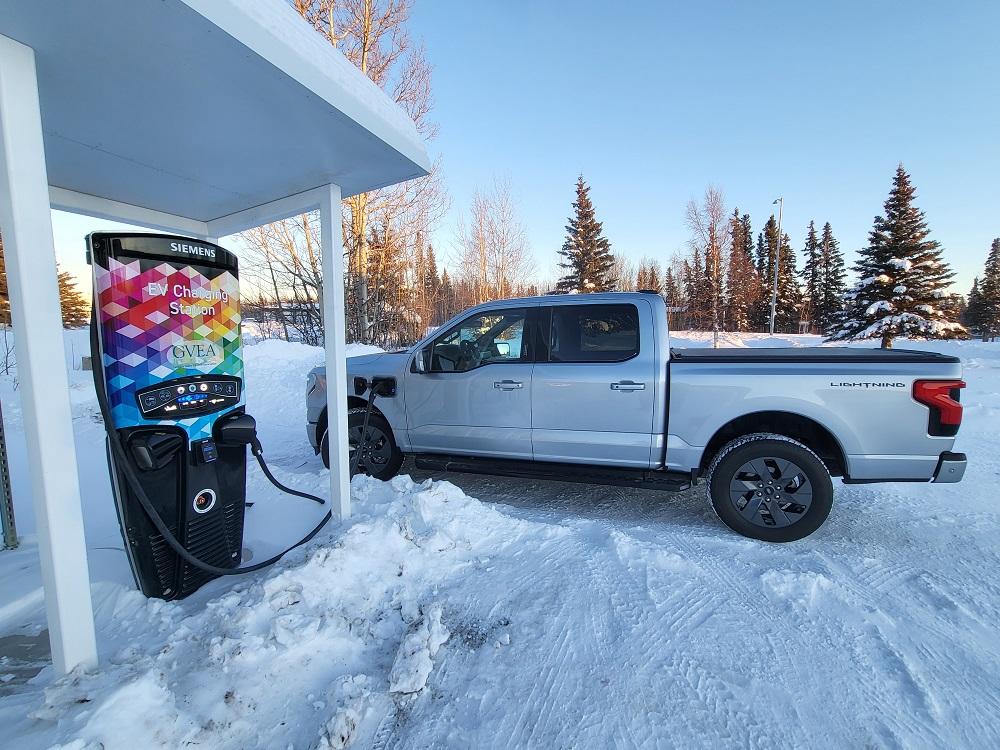
It took 76 minutes to add the 51 kWh I wanted for the return trip. For those of you who have already done the math, that doesn't match the charge rate I was seeing. That is, of course, because I was running the cabin heat for a good portion of the charge. According to the Car Scanner app, running the interior heat drew a very consistent 7-8 kW of power whenever I had climate control 'On' and Eheat selected - driving or not. I did turn off climate control to see what would happen and, somewhat surprisingly, the truck's inline heater began putting out 10-11 kW of power for about 5 minutes, then it dropped to zero. During those 5 minutes, the battery temperature sensor did increase from 24 degrees to 60 degrees. So, that confirms what others have written in the forum, heat goes to either the cabin or the battery, but apparently not at the same time. What did surprise me was that the heater was capable of providing an additional 2 kW to the battery that it didn't provide to the cabin during any portion of the drive. At -40, during the drive, the cabin had cooled down to the point where, while not unpleasant, the interior temperature could no longer be called 'warm'. I'm wondering if that extra 2 kW of heating power is never used in the cabin because it is reserved for other car warming requirements. Still an extra 2 kW of cabin heat would be nice at -40 - even with the associated range loss. While I used manual fan and climate control settings, I did select Auto climate a few times, but the temp always dropped fairly quickly in Auto. One thing I noticed (that I like): it appears there may have been some adjustment to the auto-defrost function. With my Mach E, auto-defrost was always coming on by itself and full blast. It would instantly replace warm cabin air with cold cabin air. Very unpleasant at very cold temps. I'm not sure if this improvement was by design or if I found some secret combination of manual switch positions or circumstances that overrides the annoying auto defrost.
The return trip was uneventful with remarkably consistent numbers for both legs of the trip. I did make the return trip 5-10 mph faster and attribute the nearly identical energy consumption numbers to the fact that although I was somewhat slower on the outbound leg, I was experiencing a fairly strong head wind on that leg.
1:47 PM. Sunset on the return leg:
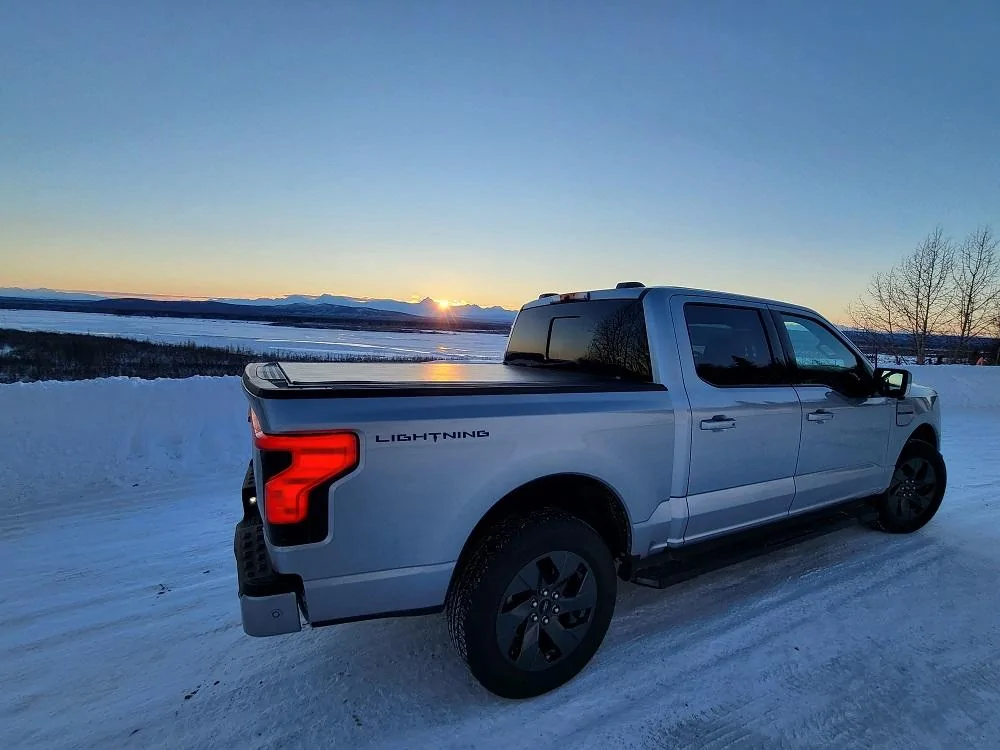
Finish:
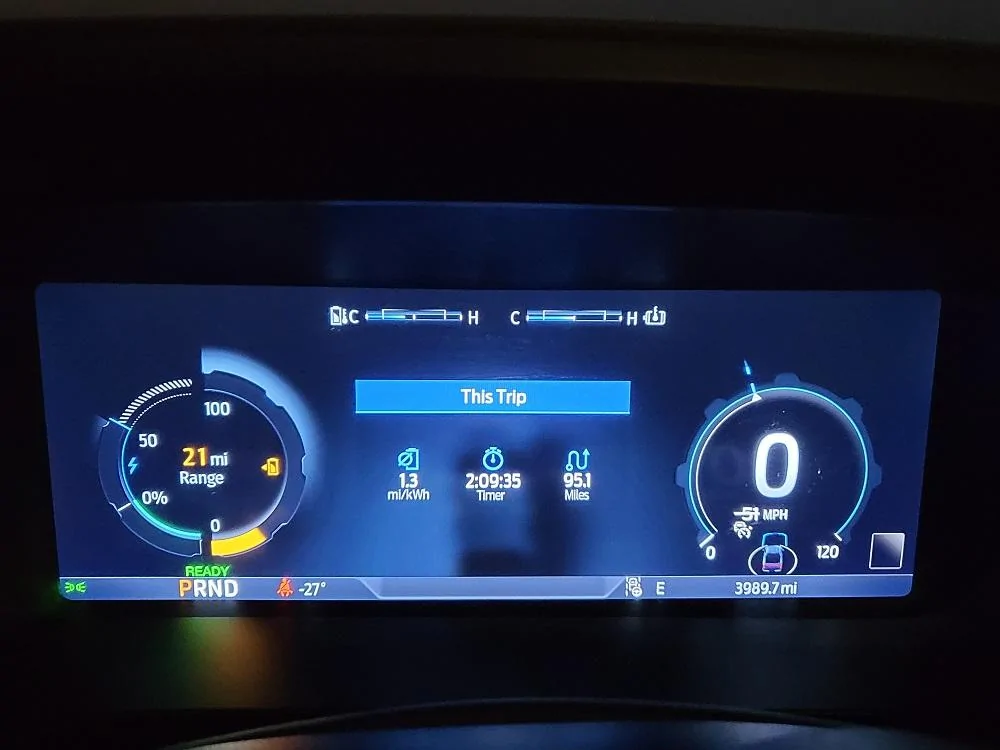
Trip Summary at -40F:
Outbound: Distance 94.5 miles, kWh used 76.19, miles\kWh 1.24
Return: Distance 95 miles, kWh used 77, miles\kWh 1.23
Summary of the three main goals:
How does extreme cold affect Lightning mechanical reliability? My experience of three winters in Alaska has been that neither the Lightning, nor the Mach E, have shown any mechanically related issues when driving in extreme cold. That wasn't the case with most of the non-EVs I've driven in the cold. Almost all of them struggled mightily to start, had easily broken fan belts, and made continuous painful noises when driving in extreme cold. Non-EVs do get the nod when it comes to growing bananas in the back seat, though.
What is the Lightning's actual cold weather range in extreme cold? On this trip, at -40, it was a remarkably consistent 1.23 mi\kWh. For the winter as a whole, since Nov 1st my Lightning has averaged right at 1.4 mi\kWh. My summer mileage was ~1.9 mi\kWh. The last two winters, my Mach E has averaged a very consistent 1.8 mi\kWh and my summer average has been ~2.8 mi\kWh. I can't verify the new cold weather GOM accuracy update because when I charged the truck to 100% prior to departure, it reset the GOM to the factory ideal range of approx. 315 miles. It wasn't until the very end of the trip before the GOM finally showed a fairly accurate range remaining that I would bet my life on.
How will extreme cold affect charging? My experience is based exclusively on 50 kW DCFC, but I've found the Lightning and Mach E charge reliably even at very cold temps. Charging performance remains fairly stable down to -20F then shows some charge rate taper below that. But in all case the vehicles charge fine. The charging station cable do get very stiff and difficult to bend in extreme cold. I am currently charging the Lightning, outside, at work (-35F) using a level 2 GrizzlE - without issue.
Other: I don't like the factory AT tires. The roads were dry(ish) for this trip and the grip was fine, but if there is any ice or packed snow, there is way too much tire slippage compared to the Continental winter tires that I bought for my Mach E. There aren't enough quality, 20" winter tire options for the Lightning.
BTW: The new Sync 4A display and the multi-purposed volume knob are nice improvements.
Sponsored
Last edited:

